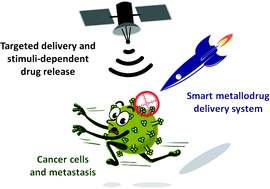Are smart delivery systems the solution to overcome the lack of selectivity of current metallodrugs in cancer therapy?
Abstract
Chemotherapeutic metallodrugs such as cisplatin and its derivatives are among the most widely applied anticancer treatments worldwide. Despite their clinical success, patients suffer from severe adverse effects while subjected to treatment due to platinum's low selectivity for tumour over healthy tissues. Additionally, intrinsic or acquired resistance to metallodrugs, as well as their inability to reach cancer metastases, often results in therapeutic failure. The evident need for highly efficient and specific treatments has driven the scientific community to research novel ways to surpass the stated limitations. Within this scenario, a rising number of smart drug delivery systems have been lately reported to target primary cancers or metastases, where the metallodrugs are released in a controlled and selective way triggered by specific tumour-related stimuli, thus suggesting a viable and attractive therapeutic approach. Herein, we discuss the main efforts undertaken in the past few years towards the smart delivery of metal-based drugs and drug candidates to tumour sites, particularly focusing on the pH- and/or redox-responsive targeted delivery of platinum and ruthenium anticancer complexes.

- This article is part of the themed collection: 2022 Frontier and Perspective articles


 Please wait while we load your content...
Please wait while we load your content...